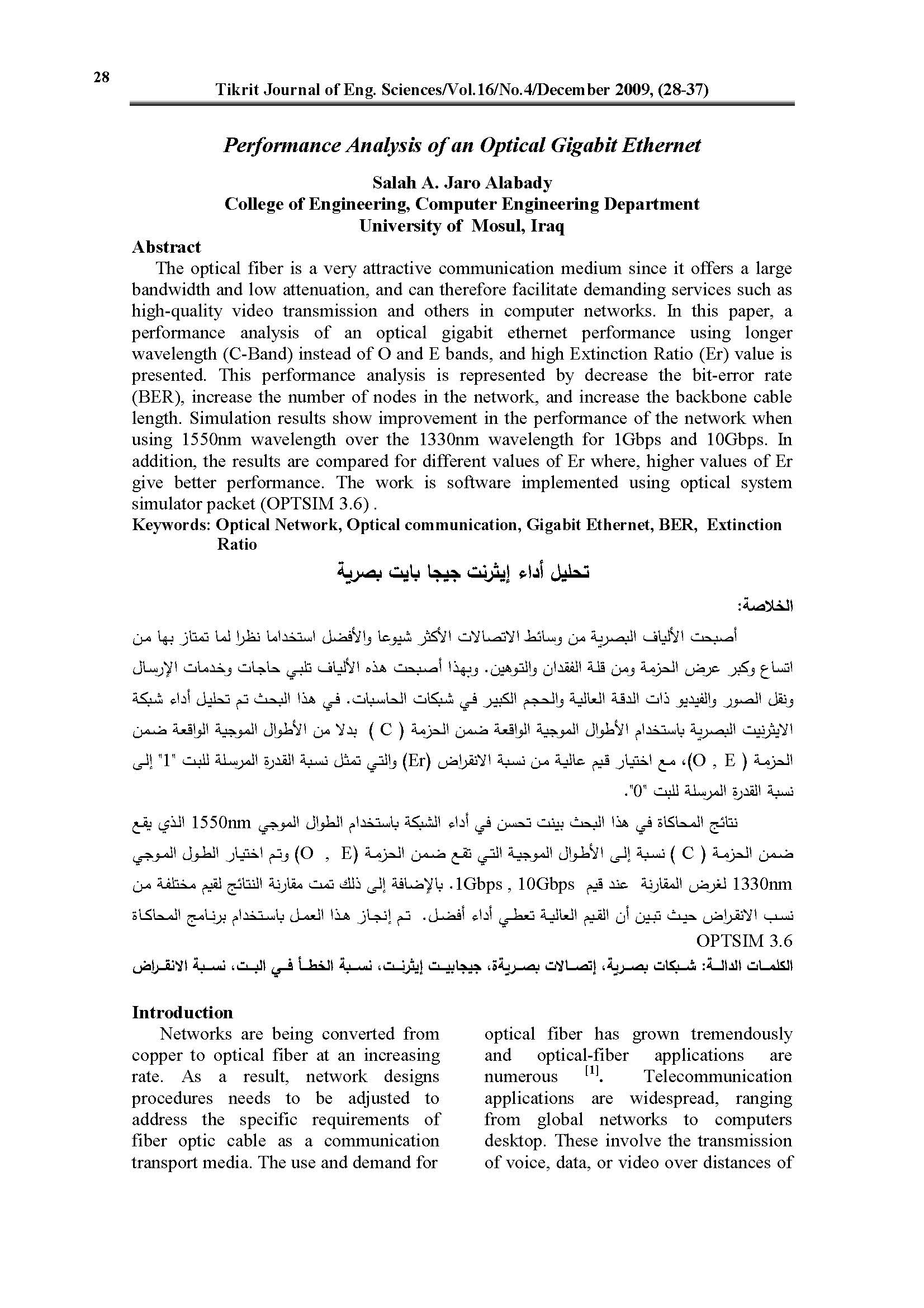Performance Analysis of an Optical Gigabit Ethernet
Main Article Content
Abstract
The optical fiber is a very attractive communication medium since it offers a large bandwidth and low attenuation, and can therefore facilitate demanding services such as high-quality video transmission and others in computer networks. In this paper, a performance analysis of an optical gigabit ethernet performance using longer wavelength (C-Band) instead of O and E bands, and high Extinction Ratio (Er) value is presented. This performance analysis is represented by decrease the bit-error rate (BER), increase the number of nodes in the network, and increase the backbone cable length. Simulation results show improvement in the performance of the network when using 1550nm wavelength over the 1330nm wavelength for 1Gbps and 10Gbps. In addition, the results are compared for different values of Er where, higher values of Er give better performance. The work is software implemented using optical system simulator packet (OPTSIM 3.6).
Metrics
Article Details

This work is licensed under a Creative Commons Attribution 4.0 International License.
THIS IS AN OPEN ACCESS ARTICLE UNDER THE CC BY LICENSE http://creativecommons.org/licenses/by/4.0/
Plaudit
References
C. Lin, “Broadband Optical Access Networks and Fiber-to-the-Home Systems Technologies and Deployment Strategies”, John Wiley & Sons Ltd, 2006. DOI: https://doi.org/10.1002/047009480X
M. J. Mahony, “Future Optical Networks “, Journal of Lightwave Technology, Vol. 24, No. 12, pp. 4684 – 4696, December 2006. DOI: https://doi.org/10.1109/JLT.2006.885765
V. Alwayn “Optical Network Design and Implementation”, Cisco Press, 2004.
M. Ming and K. Lin, “Principles and Applications of optical Communications”, McGraw-Hill, New York, 1996.
R. Kong and H. Zhou, “End-to-End Availability Analysis of Physical Network”, The Fourth International Conference on Computer and Information Technology, CIT ’04, pp. 668 – 673 ,14-16 Sept. 2004.
Y. Huang, W. Wen, J.P. Heritage, and B. Mukherjee, “A Generalized Protection Framework using a New Link-State Availability Model for Reliable Optical Networks”, Journal of Lightwave Technology, Vol. 22, No. 11, pp. 2536-2547, Nov. 2004. DOI: https://doi.org/10.1109/JLT.2004.836764
E.G.Shapiro, M.P.Fedoruk, and S.K.Turitsyn, “Numerical Estimate of BER in Optical Systems with Strong Patterning Effects”, Electronics letters. Vol. 37, No. 19,pp. 1179-1181,2001. DOI: https://doi.org/10.1049/el:20010799
Application Note, “Maintaining Average Power and Extinction Ratio, Part 1, Slope Efficiency and Threshold Current “, HFAN-02.3.1, http://www.maxim-ic.com/ appnotes. cfm/an_pk/1093, April 2002.
E. J. Mitchell, “Simulation of an Optical Network System for a Space Based High Performance Computer System”, Master thesis of Engineering in Electrical Engineering and Computer Science at the Massachusetts Institute of Technology, 2002.
Application Note 985, “Optical Signal-to-Noise Ratio and Q-Factor in Fiber-Optic Communication System”,HFAN-9.0.2, http://www.maxim-ic.com/ appnotes. cfm/an_pk/985, 2002.
P. Bijja, “Wavelength Assignment in All-Optical Networks for Mesh Topologies”, A Master Thesis of Science in Electrical Engineering in Louisiana State University, August 2002.
C. Pinart “Alternatives for In-Service BER Estimation In All-Optical Networks: Towards Minimum Intrusion “, Journal of Computer Networks, Vol. 2, No. 3, pp. 56-63, May 2007. DOI: https://doi.org/10.4304/jcp.2.3.56-63
R. Hainberger, T. Hoshida, S. Watanabe, and H. Onaka, “BER Estimation in Optical Fiber Transmission Systems Employing All-Optical 2R Regenerators,” IEEE/OSA, Journal of Lightwave Technology, vol. 22, no. 3, pp. 746– 754, March 2004. DOI: https://doi.org/10.1109/JLT.2004.824559
T. Sims, ” Designing Optical Transmission Networks Principles and Approaches ” ,16th March 2006 (Available athttp:// www. webarchive. ja.net/services/ events/ calendar/2006/optical-networking/ Verizon.pdf ).





